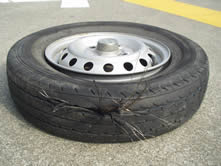We know that pressure is a force divided by area over which the force is exerted. When a person lies on a bed of nails, the force equal to the weight of that person acts on the surface of the bed containing nails. Here, the weight is distributed over hundreds of nails that makes the pressure at the tip of each nail safely small. If the same person stands on his feet, he will surely feel the sharpness of the nails because in this case the area of contact is very small. So, the weight will be distributed over a few nails and hence the pressure will be relatively large.
Friday, December 2, 2016
Thursday, December 1, 2016
What is the reason of cooler air coming out of a bursting tire?
We know from the ideal gas law that pressure increases proportionally with the increase of temperature when volume is held constant for a given mass. As the air inside the tire is in compressed state, the temperature inside the tire is high. When the tire bursts, air inside the tire comes out very fast causing a sudden expansion and decrease in temperature. Therefore, the air is relatively cooler than the surroundings. Blowout of tire occurs when the location of tearing of the tire is incapable of containing the pressurized air and the escaping air causes further tear of the tire.
Friday, March 25, 2016
How glass is broken with sound?
When any object composed of an elastic material
is disturbed, it will vibrate at its own special set of frequencies, which
together form its special sound.The frequency is the natural frequency of that
object. The tendency of one object to force another object into vibrational
motion is called forced vibration. If an unmounted tuning fork is struck, the
sound it makes is faint. Hold the base of the fork on a table top, and the
sound is relatively loud. This is because the table is forced to vibrate, and its larger surface sets more air in motion. The table top becomes a
sounding board, and can be forced into vibration with forks of various
frequencies. When the frequency of forced vibrations on an object matches the
object's natural frequency, a dramatic increase in amplitude occurs. This
phenomenon is known as resonance. A glass
has a natural frequency. Now if the pitch of the sound
creating forced vibration match the resonant frequency of glass the vibrating
air will cause the glass vibrating too. If this occur with sufficient volume,
right frequency and high enough amplitude, this will cause exceed the strength
of the glass to resist the vibrations. When the sound gets too loud for the
glass to vibrate, it breaks the glass.
Subscribe to:
Posts (Atom)


